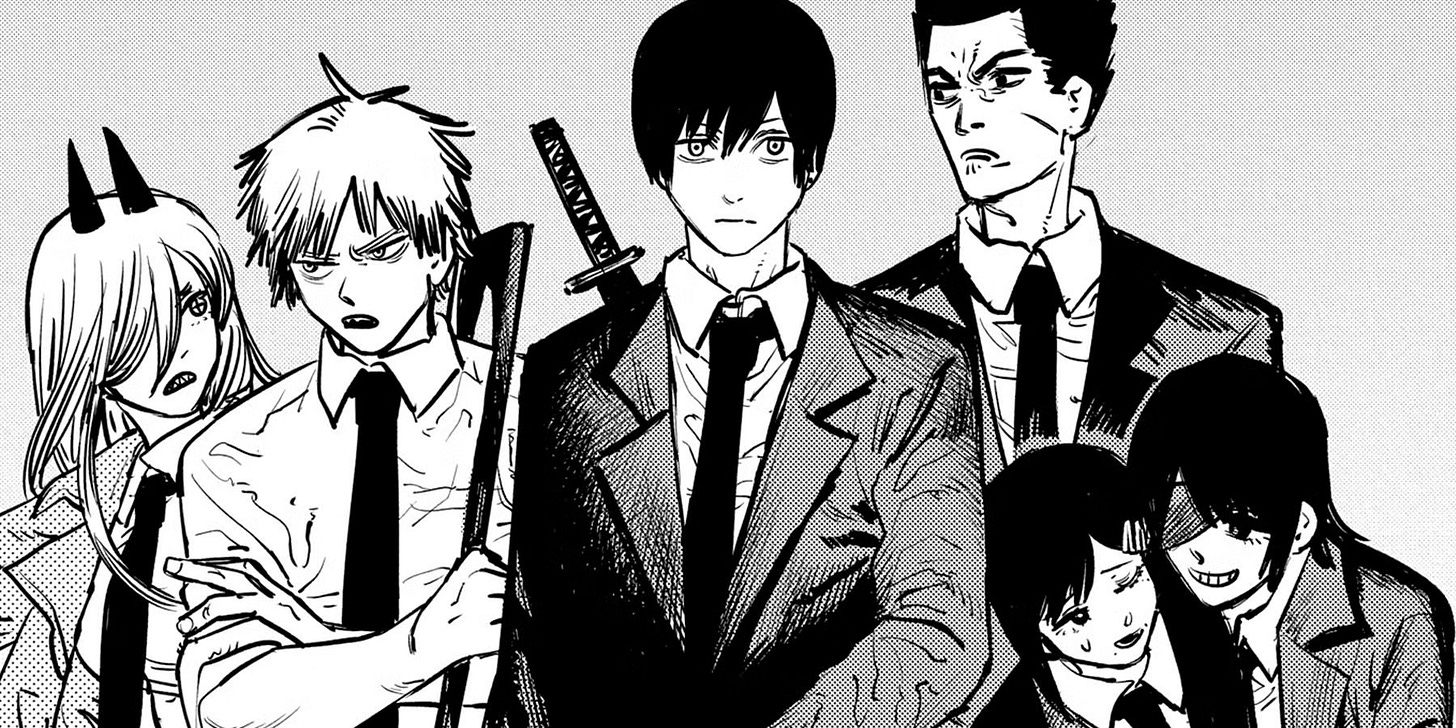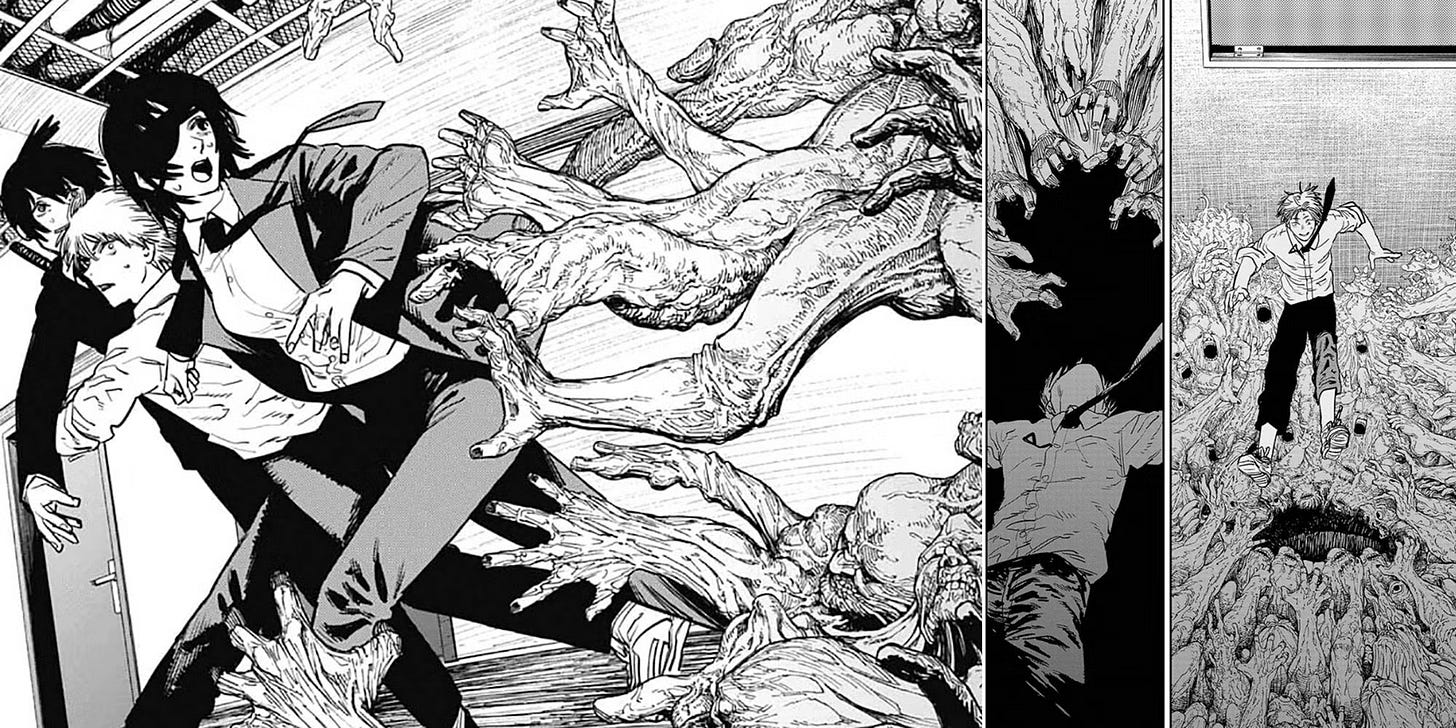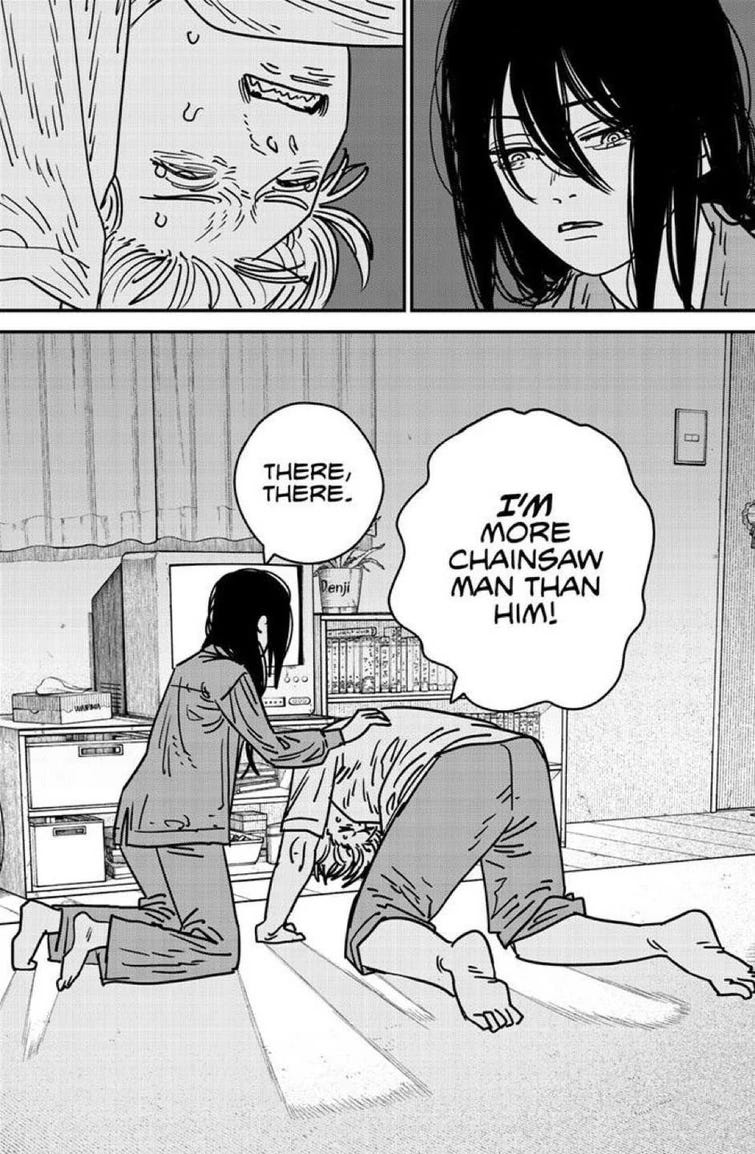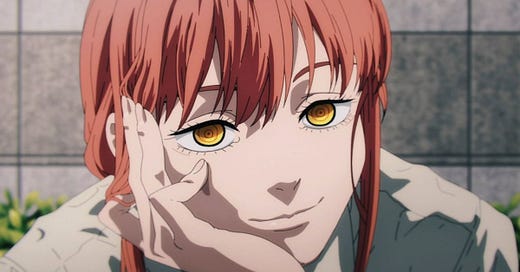There's a lot going on in Denji’s life.
Sixteen years old, down on his luck, murdered by demons, resurrected through a pact with the chainsaw devil, trapped in a cycle of manipulative abuse, and to top it all off he’s really, really horny.
Considering how tropey it at first seems, Tatsuki Fujimoto’s Chainsaw Man is a fascinatingly atypical manga. A boy who can turn into chainsaws, fighting demons that represent social fears, joining forces with a government organization that itself makes pacts with their very enemy in order to meet them on level ground.
It evokes the likes of Bleach or Jujutsu Kaisen in that it has this rogue’s gallery of extremely distinct character designs with very specific supernatural abilities, coupled with a story that increasingly escalates in scale as it progresses.
What Chainsaw Man does with that story, however, is way more meditative. Its themes are surprisingly nuanced; its flow wildly atypical for a serialized shonen manga, and I think it's because it really shouldn't be one.
At the time of writing there are 192 chapters of the manga in circulation, currently in what feels like the tail end of what’s known as the Academy Saga, the series second major arc. I first started reading Chainsaw Man about a year ago, hungrily devouring a good hundred chapters in a matter of weeks.
That first part is an extremely compelling read, especially when it reveals its hand and starts to explore its more unpleasant themes. It revels in making the reader uncomfortable, while at the same time giving them the incredibly cool action sequences they came to the series for.
I think the reveal and presentation of the Gun Devil is one of the most inspired artistic choices in the medium. I think what they do with the conclusion of that particular conflict is even more inspired. I think the unassuming, quieter moments of the series, however, are an even greater feat.
It's a brilliant thing, and despite the very different approach Fujimoto has taken with this second part, I really gel with the story he is now building: A contemplation of a society of fanatics, and an exploration of how difficult it is to attempt a ‘normal’ life in the wake of trauma.

But reading this second part has been a very different experience to the first for one specific reason: the first was already fully published at the time I read it, the second is still in progress. I think this was the wrong approach for this particular story.
Serialization of manga isn't really something I've thought about all that much, mostly because the manga I’ve read in the past have mostly been in retrospect. As such I've been able to manage the pace at which I imbibe the stories being told, choosing how and when I pick up and put down certain works.
I’m currently about 500 chapters into One Piece. I’m about to start Part 5 of JoJo's bizarre adventure. After last year’s excellent adaptation I'm giving serious thought to mainlining Delicious in Dungeon too.
I’ve always gravitated towards completed series because I find it easier to navigate what they expect of me. I have an idea of the pacing to expect, how much it will be safe for me to digest in one sitting.
I control how and when I engage with the work, on my terms, and as a result I have found it much easier to retain a grasp of the narrative threads, even when I’ve put stories down for a while.

However, with Chainsaw Man’s new chapters releasing either weekly or fortnightly, what I’m finding is that I’ll go into each one really struggling to piece together the emotional continuity of the scene from the previous entry, often wondering if it would be better to simply take a hiatus and restart the whole endeavour once this particular arc has come to a close.
Part of the problem is self evident: the publication schedule is very haphazard and inconsistent, to the degree that in most cases when a chapter drops I only know about it because someone has posted an incredibly specific meme that's entered my online sphere.
I’m always excited to get stuck in whenever a new chapter drops, but that joy is always tempered with a brief bout of confusion and a few minutes of trying to piece together what feelings I'm supposed to have retained from the last time I read it.
I think on a more fundamental level the story being told isn’t one that lends itself to be segmented in such a way. In a very real sense it feels like Fujimoto is wrestling with the standardisation of the format he’s working in, and this does make sense when you look at his previous body of work.
Obviously Chainsaw Man is not his first serialised work, he had previously created Fire Punch (which I’ve not read yet so keep that in mind while you’re following my argument), but the bulk of his collective works are predominantly short stories and ‘one shots’.
Works like Goodbye, Eri and Look Back that make brilliant use of the medium but definitely feel like things to be enjoyed in a single sitting, not something to string together over a haphazard schedule and a long period of time.

That's the rub with this body of work. Fujimoto understands the medium, and has the artistic conviction to tell his story even if it doesn't quite fit the format demanded of it. That's what's so exciting about Chainsaw Man as an artistic expression, why I keep digging away at it despite my grumblings about its release schedule.
He allows entire chapters where nothing happens because he knows that those are the chapters where everything is happening. A deep breath on the page to centre the mind and steady the heart before the plot launches into its next manic phase.
Rhythm exists there, much like any good Manga, but for me it's just at a different tempo than what best suits the serialization format.
There’s a second element to my issues with the drip feeding of Chainsaw Man’s story, one that at first might seem like a contradiction with my previously discussed frustrations but at the same time is the root cause of them: Fujimoto’s health and wellbeing.
There’s a sequence in JoJo’s Bizarre Adventure Part 4 in which the gang meet famous manga author Kishibe Rohan, an artist whose work is lauded not only for its quality, but also the speed with which he produces it. Drawing up a full week’s worth of pages in a single day, through the power of his Stand Heaven’s Door.
It’s a great bit of prescient social commentary about the pressures Mangaka face in delivering their work in this weekly serialized format, and this was from a Manga that was first published in the early 90s. Things have gotten far more dire since.
Over the past few years we’ve seen an uptick in early deaths of famous Mangaka. Kentaro Miura, author of Berserk, passed away in May of 2021 at the age of 54. Last year it was Akira Toriyama at 68. Yu-Gi-Oh creator Kazuki Takahashi left us in 2022 at 60.
For those still with us, a longstanding history of intermittent hiatuses have been needed due to ill health for artists such as One Piece’s Eichiro Oda and Hunter X Hunter’s Yoshihiro Togashi.
While not explicitly linked, much of the running thread between all of these people are the conditions within which they have entombed themselves in order to get the work out on time and at a consistent quality for their own standards.
Long days. Breaks few and far between. Self neglect as a necessary payment for the the pact they themselves have made with not only the creative spirit but the structure within which such harsh deadlines are even demanded.
Tatsuki Fujimoto is a much younger man than many of his peers, sitting firmly at the start of his career. At the tender age of 32 he has his whole life ahead of him, and yet I worry what toll his lethal work schedule is having on him already.
For a work from someone who is explicitly an artist as much as he is a storyteller, you can see a contrast in the intricacy of his work between earlier and later chapters of the manga, as well as his one shots.
Lines simplified, details muted, still some absolutely brilliant character expression work, but as a whole it feels like a diminished output, one explicitly the result of what are definitely deadlines far too stringent.
This is not baseless speculation, but built upon the words of the creator himself. In an interview as discussed in this article from Kotaku, the Mangaka admitted that his desire for more intricate linework and shading is basically impossible with the resources and schedule he has to work with.

And with both of these things in mind, I can’t help but wonder what the whole endeavour might have looked like had Fujimoto been allowed to complete the whole work prior to publication.
I can’t speak to the decisions being made by either publisher Shonen Jump or the artist himself, and maybe with the time, money and freedom to do whatever he wants, he might still produce the same work at the same level of quality.
In that same channel of thought, however, it does all seem like a dreadful compromise, and an expression of talent on the part of the creator that their output is still so good in spite of all this.
Time limits can be empowering, of course. Part of the reason I started this Substack is that I wanted to see what I was capable of when I didn't give myself infinite time to tool around with my ideas.
But as some long term readers will know, sometimes I have to take breaks. I can do this because this is not my day job, and my output is nowhere near as intricate or high quality as what's being produced by these brilliant, overworked, likely underpaid, artists.
Creating on your own terms. Engaging on your own terms. If nothing else we are all beholden to forces of control far beyond our reach, which is why I’ve found catching up with the creator such a frustrating experience.
But within those restraints there lies a kernal of something resistant. An implicit kinship between reader and artist, excitedly diving into the chaos of the void together.
And as much as I find myself conflicted by the very format this work is being delivered through, I am comforted by the knowledge that i’m not one of those fans.
You know the ones I mean.






I lapse on series for a few months when I do get caught up so I find it odd how insistent folk are that reading weekly is the best way to experience these stories, I'm more than happy to wait wish publishers felt the same way.
Maybe it's not useful to point out but Kazuki Takahashi died in a diving accident I'm sure he had a bad work life balance as well but he sort of sticks out in that line up.